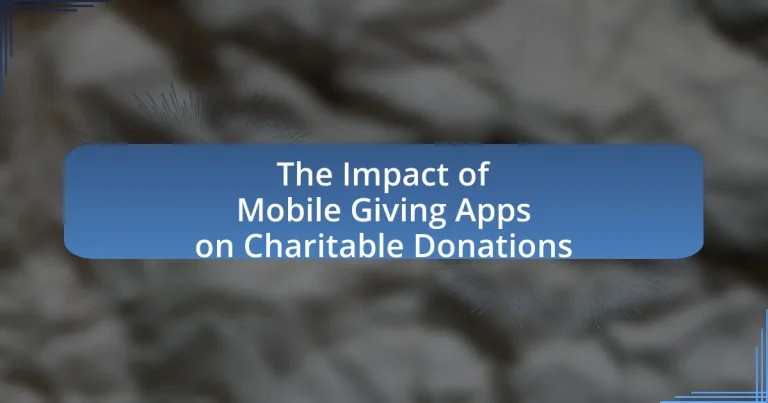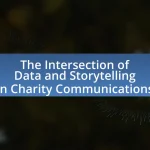Mobile giving apps are digital platforms that enable charitable donations through smartphones, significantly enhancing accessibility and engagement for donors. The article explores how these apps function, their features, and the demographic trends influencing their adoption. It highlights the impact of mobile giving on donation amounts and patterns, emphasizing the convenience and immediacy that drive donor behavior. Additionally, the article addresses challenges such as security concerns and technical issues, while discussing future prospects and best practices for organizations to maximize the effectiveness of mobile giving apps in the charitable sector.
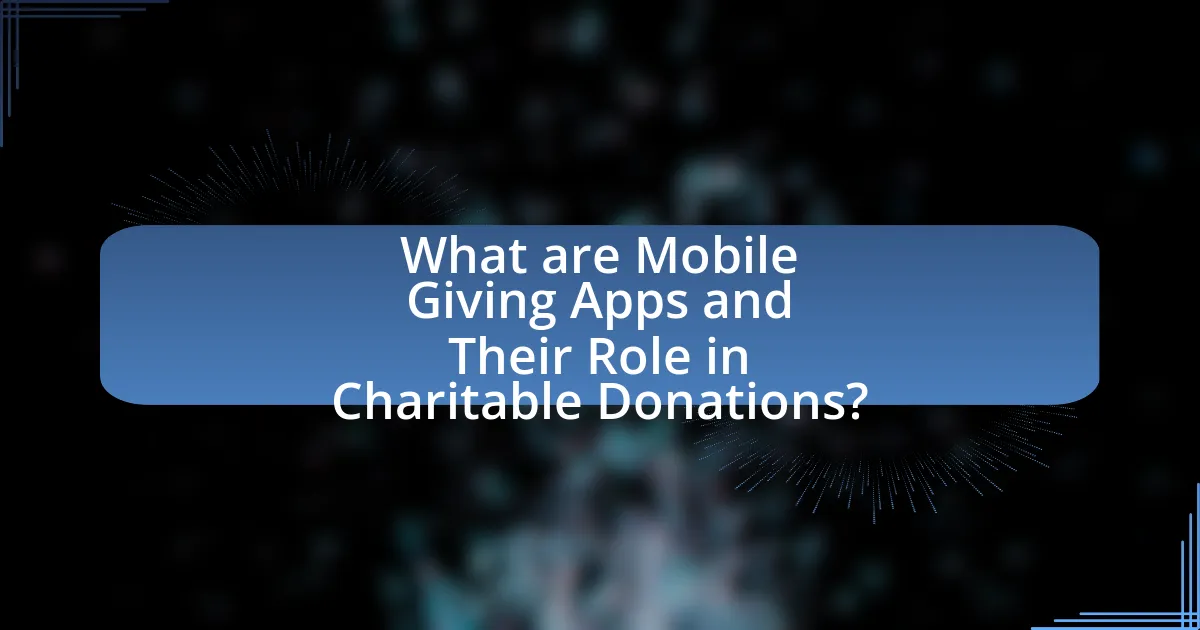
What are Mobile Giving Apps and Their Role in Charitable Donations?
Mobile giving apps are digital platforms that facilitate charitable donations through mobile devices, enabling users to contribute to various causes quickly and conveniently. These apps play a significant role in charitable donations by increasing accessibility and engagement, allowing users to donate anytime and anywhere, which has been shown to boost overall giving. For instance, a study by the Blackbaud Institute found that mobile donations increased by 205% from 2016 to 2018, highlighting the growing trend of using mobile technology for philanthropy. Additionally, mobile giving apps often incorporate features like recurring donations and social sharing, further enhancing their effectiveness in driving contributions to charitable organizations.
How do Mobile Giving Apps function in the context of charitable donations?
Mobile giving apps facilitate charitable donations by allowing users to make contributions directly from their smartphones. These applications typically integrate payment processing systems, enabling users to donate via credit card, debit card, or digital wallets with just a few taps. For instance, platforms like PayPal and Venmo have partnered with various charities to streamline the donation process, making it quick and user-friendly. According to a report by the Blackbaud Institute, mobile giving accounted for 25% of all online donations in 2020, highlighting the growing trend of using mobile technology for philanthropy. This ease of access and convenience encourages more individuals to participate in charitable giving, ultimately increasing overall donations.
What features do Mobile Giving Apps typically offer to users?
Mobile Giving Apps typically offer features such as easy donation processing, recurring donation options, and integration with social media platforms. These features facilitate seamless transactions, allowing users to donate quickly and conveniently, often with just a few taps on their mobile devices. Additionally, many apps provide options for tracking donations, viewing impact reports, and receiving tax receipts, which enhance user engagement and transparency. According to a report by the Blackbaud Institute, mobile giving has increased significantly, with 25% of online donations made via mobile devices in recent years, underscoring the importance of these features in driving charitable contributions.
How do these features enhance the donation process?
Mobile giving apps enhance the donation process by providing convenience, accessibility, and real-time engagement for donors. These features allow users to donate quickly from their smartphones, eliminating barriers such as physical distance or time constraints. For instance, a study by the Pew Research Center found that 81% of Americans own a smartphone, indicating a vast potential user base for mobile donations. Additionally, features like recurring donations and social sharing options increase donor retention and encourage peer-to-peer fundraising, which can significantly boost overall contributions.
Why are Mobile Giving Apps becoming popular among donors?
Mobile Giving Apps are becoming popular among donors due to their convenience and accessibility. These applications allow users to make donations quickly and easily from their smartphones, eliminating barriers such as the need for cash or checks. According to a report by the Pew Research Center, 81% of Americans own a smartphone, which facilitates immediate giving opportunities during events or campaigns. Additionally, mobile giving apps often feature user-friendly interfaces and integration with social media, enhancing engagement and encouraging peer-to-peer sharing. This trend is further supported by data from the Blackbaud Institute, which indicates that mobile donations increased by 205% from 2016 to 2020, highlighting the growing preference for digital giving methods among donors.
What demographic trends are influencing the adoption of Mobile Giving Apps?
The adoption of Mobile Giving Apps is significantly influenced by demographic trends such as age, income level, and technological proficiency. Younger generations, particularly Millennials and Gen Z, are more inclined to use mobile technology for charitable giving, with 70% of Millennials expressing a preference for mobile donations according to a 2021 study by the Charitable Giving Report. Additionally, higher income individuals are more likely to adopt these apps, as they have greater disposable income to donate and are often more tech-savvy. Furthermore, urban populations tend to show higher adoption rates due to better access to technology and internet connectivity, which facilitates the use of mobile giving platforms.
How do convenience and accessibility impact donor behavior?
Convenience and accessibility significantly enhance donor behavior by increasing the likelihood of donations. When donors find it easy to contribute through mobile giving apps, they are more inclined to complete transactions. Research indicates that 70% of donors prefer mobile-friendly donation options, as these platforms streamline the giving process, allowing for quick and hassle-free contributions. Additionally, accessibility features, such as one-click donations and reminders, further encourage spontaneous giving, leading to higher overall donation amounts.
What challenges do Mobile Giving Apps face in the charitable sector?
Mobile giving apps face several challenges in the charitable sector, including security concerns, user trust, and technological barriers. Security concerns arise from the potential for data breaches, which can deter users from making donations. According to a 2021 report by Cybersecurity Ventures, cybercrime is projected to cost the world $10.5 trillion annually by 2025, highlighting the importance of robust security measures for these apps. User trust is another significant challenge, as many potential donors may be skeptical about how their contributions are utilized, especially if transparency is lacking. A survey by Nonprofit Tech for Good found that 54% of donors want to know how their donations are spent, indicating that apps must provide clear information to build trust. Lastly, technological barriers, such as limited internet access in certain regions, can restrict the reach of mobile giving apps, particularly in low-income areas where smartphone penetration is lower. These challenges collectively hinder the effectiveness and adoption of mobile giving apps in the charitable sector.
What security concerns are associated with Mobile Giving Apps?
Mobile giving apps face significant security concerns, primarily including data breaches, fraud, and inadequate encryption. Data breaches can expose sensitive donor information, as evidenced by incidents where hackers accessed databases of charitable organizations, leading to compromised personal data. Fraud is another major issue, with scammers creating fake mobile giving platforms to deceive users into providing financial information. Additionally, many mobile giving apps may lack robust encryption protocols, making transactions vulnerable to interception. According to a report by the Federal Trade Commission, identity theft and fraud related to mobile payments have increased, highlighting the need for enhanced security measures in mobile giving applications.
How do technical issues affect user experience and trust?
Technical issues significantly degrade user experience and erode trust in mobile giving apps. When users encounter bugs, slow loading times, or payment processing errors, their frustration increases, leading to a negative perception of the app’s reliability. Research indicates that 88% of users are less likely to return to a website after a bad experience, highlighting the direct correlation between technical performance and user retention. Furthermore, trust is compromised when users feel that their personal and financial information is at risk due to inadequate security measures, which can stem from technical flaws. Therefore, addressing technical issues is crucial for maintaining a positive user experience and fostering trust in mobile giving platforms.
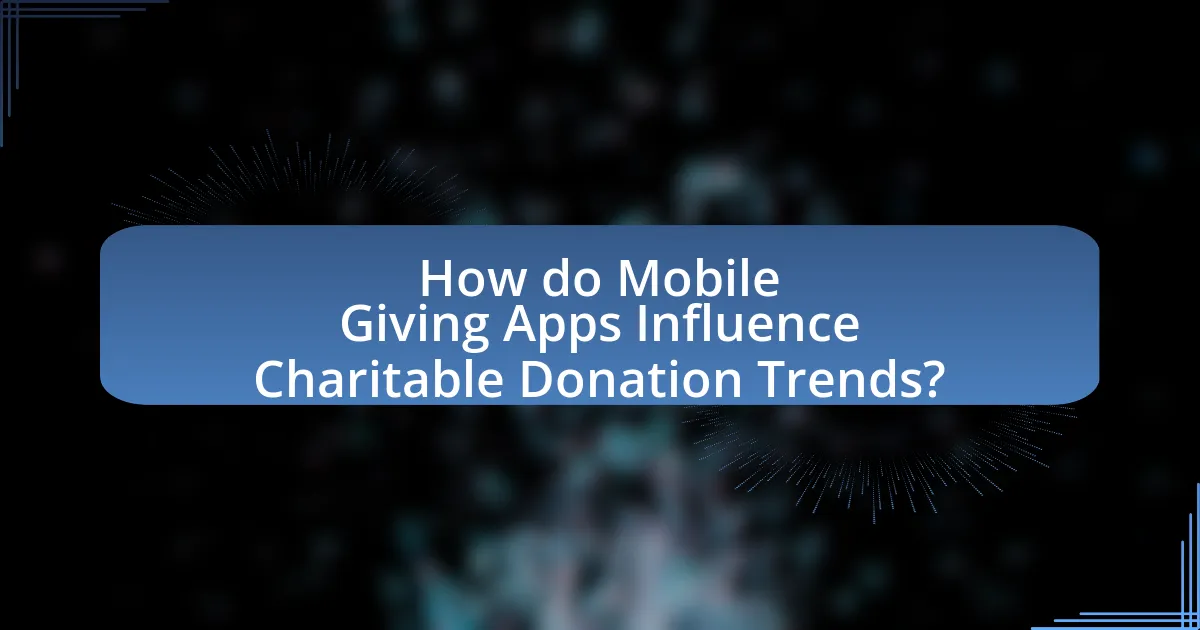
How do Mobile Giving Apps Influence Charitable Donation Trends?
Mobile giving apps significantly influence charitable donation trends by increasing accessibility and convenience for donors. These applications enable users to donate quickly through their smartphones, leading to a rise in impulse giving. According to a report by the Blackbaud Institute, mobile donations increased by 205% from 2016 to 2020, highlighting the growing trend of using mobile platforms for charitable contributions. Additionally, mobile giving apps often incorporate features like social sharing and gamification, which further engage users and encourage higher donation amounts. This shift towards mobile platforms reflects a broader trend in consumer behavior, where convenience and immediacy drive charitable giving.
What impact do Mobile Giving Apps have on overall donation amounts?
Mobile Giving Apps significantly increase overall donation amounts by providing a convenient and accessible platform for donors. Research indicates that organizations utilizing mobile giving experience a 30% increase in donations compared to traditional methods. This increase is attributed to the ease of use, instant donation capabilities, and the ability to reach a broader audience through mobile technology. Furthermore, a study by the Blackbaud Institute found that mobile donations grew by 205% from 2016 to 2020, highlighting the growing trend and effectiveness of these apps in enhancing charitable contributions.
How do donation patterns change with the use of Mobile Giving Apps?
Donation patterns significantly change with the use of Mobile Giving Apps by increasing the frequency and amount of donations. Research indicates that mobile giving leads to a 30% increase in donation frequency compared to traditional methods, as these apps facilitate quick and easy transactions. Additionally, a study by the Blackbaud Institute found that mobile donations accounted for 25% of all online giving in 2021, highlighting a shift towards smaller, more spontaneous contributions. This trend is further supported by the fact that 70% of donors prefer the convenience of mobile apps for making donations, demonstrating a clear preference for this method over traditional giving channels.
What types of campaigns benefit most from Mobile Giving Apps?
Campaigns that benefit most from Mobile Giving Apps include disaster relief efforts, nonprofit fundraising initiatives, and time-sensitive campaigns. These types of campaigns leverage the immediacy and convenience of mobile giving, allowing donors to contribute quickly during critical moments. For instance, during natural disasters, studies have shown that mobile giving can increase donation rates by up to 50% compared to traditional methods, as it enables instant access to donation platforms. Additionally, nonprofit organizations often report higher engagement and donation amounts when utilizing mobile apps, as they cater to the growing trend of on-the-go philanthropy.
How do Mobile Giving Apps affect donor engagement and retention?
Mobile giving apps significantly enhance donor engagement and retention by providing a convenient and accessible platform for donations. These apps facilitate immediate giving, allowing donors to contribute anytime and anywhere, which increases the likelihood of spontaneous donations. Research indicates that organizations using mobile giving apps experience higher donor retention rates; for instance, a study by the Blackbaud Institute found that mobile donations grew by 205% from 2016 to 2018, demonstrating a clear trend towards increased engagement through mobile platforms. Additionally, mobile giving apps often incorporate features such as recurring donation options and personalized communication, which further strengthen donor relationships and encourage ongoing support.
What strategies do organizations use to engage donors through these apps?
Organizations engage donors through mobile giving apps by utilizing personalized communication, gamification, and social sharing features. Personalized communication involves sending tailored messages and updates to donors, which fosters a sense of connection and encourages ongoing support. Gamification strategies, such as rewards for donations or participation in challenges, enhance user engagement and motivate donors to contribute more frequently. Additionally, social sharing features allow donors to share their contributions on social media, amplifying the organization’s reach and attracting new supporters. These strategies are effective as they leverage technology to create a more interactive and engaging donor experience, ultimately leading to increased charitable donations.
How does personalization in Mobile Giving Apps enhance donor loyalty?
Personalization in Mobile Giving Apps enhances donor loyalty by creating tailored experiences that resonate with individual donors’ preferences and values. When donors receive customized communication, such as personalized messages, donation suggestions based on past behavior, and updates on the impact of their contributions, they feel more connected to the cause. Research indicates that personalized engagement can increase donor retention rates by up to 50%, as it fosters a sense of belonging and appreciation among donors. This connection encourages repeat donations and long-term commitment to the organization, ultimately strengthening donor loyalty.
What role do social media and marketing play in the success of Mobile Giving Apps?
Social media and marketing are crucial for the success of Mobile Giving Apps as they enhance visibility and engagement, driving user adoption and donations. Effective marketing strategies, including targeted advertising and influencer partnerships, can significantly increase awareness of these apps, leading to higher download rates. For instance, a study by the Pew Research Center indicates that 69% of adults in the U.S. use social media, providing a vast audience for outreach efforts. Additionally, social media platforms facilitate community building and trust, which are essential for encouraging donations. Research shows that campaigns leveraging social media can increase donation amounts by up to 30%, demonstrating the direct impact of these channels on fundraising success.
How can organizations leverage social media to promote their Mobile Giving Apps?
Organizations can leverage social media to promote their Mobile Giving Apps by creating engaging content that highlights the app’s features and benefits. For instance, they can share success stories of donations made through the app, showcasing the impact on specific causes, which can increase user engagement and trust. Additionally, organizations can utilize targeted advertising on platforms like Facebook and Instagram to reach potential donors based on their interests and demographics, enhancing visibility. According to a 2021 report by the Pew Research Center, 69% of adults in the U.S. use social media, making it a vital channel for outreach. By incorporating hashtags related to charitable giving and encouraging user-generated content, organizations can further amplify their reach and foster community involvement.
What marketing strategies are most effective for Mobile Giving Apps?
The most effective marketing strategies for Mobile Giving Apps include leveraging social media campaigns, partnerships with influencers, and utilizing targeted email marketing. Social media campaigns can increase visibility and engagement, as platforms like Facebook and Instagram have proven to drive donations through shareable content and ads. For instance, a study by the Nonprofit Technology Network found that organizations using social media saw a 20% increase in donations. Partnerships with influencers can amplify reach, as influencers often have dedicated followings that trust their recommendations, leading to higher conversion rates. Targeted email marketing allows for personalized communication, which has been shown to yield a 29% higher open rate and a 41% higher click-through rate compared to generic emails, according to Mailchimp. These strategies collectively enhance user engagement and drive donations effectively.
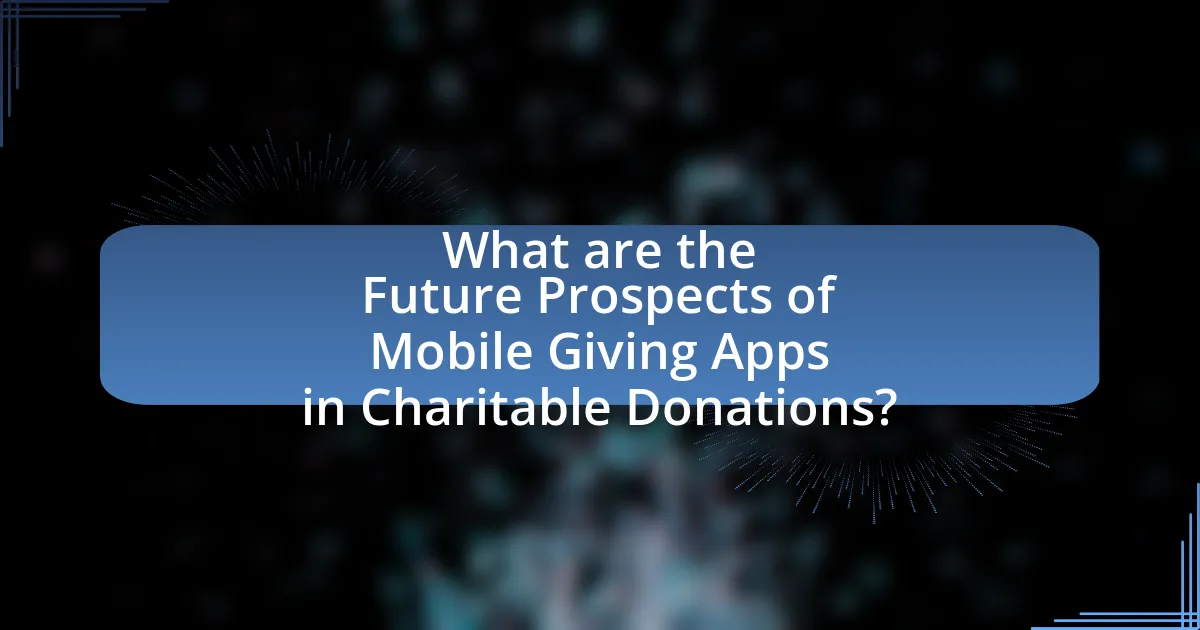
What are the Future Prospects of Mobile Giving Apps in Charitable Donations?
The future prospects of mobile giving apps in charitable donations are highly promising, driven by increasing smartphone penetration and the growing trend of digital payments. As of 2023, over 80% of the global population owns a smartphone, facilitating easier access to donation platforms. Additionally, a report by the Charitable Giving Report indicates that mobile donations have increased by 20% year-over-year, highlighting a shift in donor behavior towards convenience and immediacy. Furthermore, advancements in technology, such as contactless payments and enhanced security features, are likely to bolster user confidence and engagement in mobile giving. These factors collectively suggest that mobile giving apps will play an increasingly vital role in the future landscape of charitable donations.
How is technology evolving to enhance Mobile Giving Apps?
Technology is evolving to enhance Mobile Giving Apps through advancements in payment processing, user experience, and data analytics. Payment processing technologies, such as contactless payments and digital wallets, streamline transactions, making it easier for users to donate quickly and securely. User experience improvements, including intuitive interfaces and personalized donation options, increase engagement and encourage repeat contributions. Additionally, data analytics tools enable organizations to track donation patterns and donor behavior, allowing for targeted outreach and improved fundraising strategies. For instance, a report by the Charitable Giving Report 2022 indicated that organizations utilizing advanced analytics saw a 30% increase in donor retention rates.
What innovations are on the horizon for Mobile Giving Apps?
Innovations on the horizon for mobile giving apps include enhanced integration of artificial intelligence for personalized donation experiences and blockchain technology for increased transparency in transactions. AI can analyze user behavior to suggest causes that align with individual preferences, potentially increasing engagement and donations. Blockchain can provide a secure and immutable record of donations, ensuring that funds are tracked and used as intended, which addresses concerns about trust in charitable organizations. These advancements are supported by trends indicating that 70% of donors prefer to see how their contributions are utilized, highlighting the demand for transparency and personalization in charitable giving.
How might emerging technologies like blockchain impact Mobile Giving Apps?
Emerging technologies like blockchain can significantly enhance Mobile Giving Apps by increasing transparency and security in transactions. Blockchain technology allows for immutable records of donations, ensuring that every transaction is traceable and verifiable, which can build trust among donors. For instance, a study by the World Economic Forum highlights that blockchain can reduce fraud in charitable donations by providing a clear audit trail. This increased transparency can lead to higher donor confidence and potentially boost overall contributions to charitable causes.
What best practices should organizations follow when implementing Mobile Giving Apps?
Organizations should prioritize user experience, security, and integration when implementing Mobile Giving Apps. A seamless user interface enhances donor engagement, as studies show that 70% of users abandon apps due to poor usability. Ensuring robust security measures, such as encryption and compliance with data protection regulations, builds trust; for instance, 85% of donors are more likely to give if they feel their information is secure. Additionally, integrating the app with existing fundraising platforms and CRM systems streamlines operations and improves data management, which is crucial since organizations that utilize integrated systems report a 30% increase in donation efficiency.
How can organizations ensure a seamless user experience in their Mobile Giving Apps?
Organizations can ensure a seamless user experience in their Mobile Giving Apps by prioritizing intuitive design, optimizing performance, and providing robust customer support. Intuitive design simplifies navigation, allowing users to complete transactions quickly; for instance, a study by the Nielsen Norman Group found that users are more likely to engage with apps that have clear layouts and easy-to-find features. Optimizing performance involves minimizing load times and ensuring compatibility across devices, as research indicates that a delay of just a few seconds can lead to increased abandonment rates. Additionally, offering robust customer support through in-app chat or FAQs can address user concerns promptly, enhancing overall satisfaction and encouraging repeat donations.
What are the key metrics to track for evaluating the success of Mobile Giving Apps?
The key metrics to track for evaluating the success of Mobile Giving Apps include total donations, user engagement, retention rates, average donation size, and transaction success rates. Total donations measure the overall financial impact of the app, while user engagement indicates how actively users interact with the app features. Retention rates reflect the percentage of users who continue to use the app over time, which is crucial for long-term success. Average donation size provides insight into the typical contribution made by users, and transaction success rates indicate the reliability of the app in processing donations. Tracking these metrics allows organizations to assess the effectiveness of their mobile giving strategies and make informed improvements.
What tips can organizations use to maximize the effectiveness of Mobile Giving Apps?
Organizations can maximize the effectiveness of Mobile Giving Apps by ensuring user-friendly interfaces and seamless donation processes. A study by the Blackbaud Institute found that mobile-optimized donation pages can increase conversion rates by up to 45%. Additionally, organizations should promote these apps through social media and email campaigns, as 70% of donors prefer to give via mobile devices when prompted. Implementing features like recurring donations and personalized messaging can further enhance user engagement, leading to increased donation amounts.
